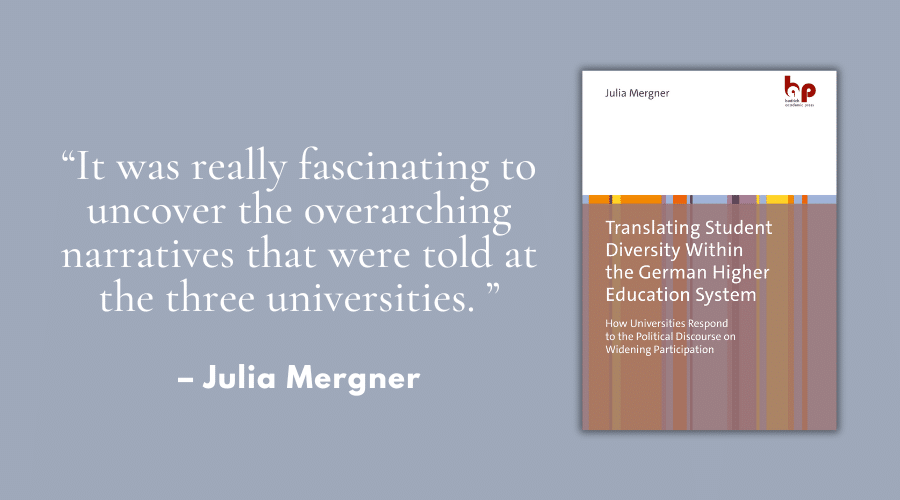How do universities respond to the institutional demand to deal with an increasingly heterogeneous student body? We conducted an interview with Julia Mergner, author of the book “Translating Student Diversity Within the German Higher Education System. How Universities Respond to the Political Discourse on Widening Participation”. In this interview, we are asking about the background of the book and the most important findings.
Interview on “Translating Student Diversity Within the German Higher Education System”
Dear Julia Mergner, could you briefly tell us what your publication is about?
The publication contains results from my dissertation, in which I examined from an organizational sociological perspective the German widening participation policy discourse and how universities respond to the institutional demand to deal with an increasingly heterogeneous student body. I investigated organizational responses at three German universities as case studies that differ according to type of institution, location and profile. The results of my study show how differently universities translate the idea of student diversity into their local context and legitimize strategies, structures and practices to deal with it.
What was the impetus for this publication?
When I started to work in the field of higher education research thirteen years ago, one of my main interests was how universities deal with student diversity and educational inequalities, which was also strongly related to my own personal experiences as a first-generation student. What surprised me, when I looked at official documents or interviewed persons working at universities, they seem to have fundamentally different understandings of student diversity and what are appropriate ways of dealing with it.
At some universities, there was an emphasis on the diverse levels of prior mathematical knowledge of students entering higher education. Thus, they argued, students need more time to fill knowledge gaps, which led to the implementation of extended introductory phases of study. Other universities focus on the diverse interests and motivations that students brought with them that could not be satisfied within the strict and predefined study plans of Bachelor’s and Master’s study programs. Therefore, they identified the development of free time slots in study programs that students can fill with lectures or activities they were interested in as the best solution. Interestingly, I noticed, that the definitions of diversity seemed to somehow correspond to certain structural or cultural characteristics of the universities, depending on their profile, history, size or student composition. However, this observation seemed to contradict the assumptions of organizational theories that I had studied during my Master’s. Here, universities were described as ‘organized anarchies’ (Cohen/March/Olsen 1972) or ‘loosely coupled systems’ (Weick 1976). When they are confronted with external demands, it was argued, they only adopt these as ‘rational myths’ (Meyer/Rowan 1977) in order to preserve legitimacy, while their organizational practice remains unaffected. But what I observed was that there was a clear and well-fitting agenda with a common understanding that resulted in actual measures! That was when I decided to spend more time on this topic and turn it into a PhD thesis.
Which findings surprised you the most?
For me, it was really fascinating to uncover the overarching narratives that were told at the three universities. In these narratives, the idea of student diversity was framed against the background of the respective local contexts so that it made sense to the storytellers and their local audiences at the universities. These narratives framed the internal discussion about student diversity in such an influential way, having a direct impact on their daily routines and teaching activities. For me, it was eye-opening to see how these narratives were used to weave the idea of student diversity to certain characteristics of their institution, but also to diversity perspectives on student diversity or paradigms that were dominant there. Thus, it was really the local context that plays the prominent role in the translation process.
Could you tell which approaches have proved most successful in implementing diversity among students at the university?
I examined the universities’ responses to student diversity on the three levels of strategy, structure and practices. For a successful implementation, two aspects seem to be important: A strategic guiding principle concerning student diversity that connects the three levels and the structural anchoring of the widening participation initiative within the structures of the university. Concerning practices to deal with student diversity, one of the most important findings was that there is no ‘one size fits all’ solution to deal with student diversity. On the contrary, offering a plurality of different organizational practices might actually be more appropriate in the face of the heterogeneous needs and interests of students who enter universities.
Which further questions arise from your findings? Where is it interesting to take a closer look?
There are many interesting avenues for future research arising from these findings. First, it would be interesting to verify the findings in other German universities, while accounting for the influence of other institutional characteristics. Second, it would also be very interesting to see how the idea of student diversity is intertwined with other highly value-loaded concepts that have become even more important in the last five years, like digitalization. This is particularly interesting because the Covid pandemic has led to very dynamic developments in the world of higher education, with profound consequences for studying and teaching.
About Julia Mergner
Since 09/2023
Postdoc at the Division of Academic Teaching & Faculty Development, Center for Higher Education, Technical University of Dortmund
09/2019 – 08/2023
Study and writing consultant, Study and Career Counselling Service at the University of Oldenburg
10/2018 – 08/2019
Study program coordinator of an online M.Sc. “Wind Energy Systems” at the University of Kassel
12/2014-12/2018
Phd/research assistant in the junior research group “StuFHe” at the Faculty for Education, University of Hamburg
12/2011-10/2014
Research assistant at the German Centre for higher education research and science studies
Education:
10/2015-06/2021
Doctorate (Dr. rer. pol.) at the Faculty for Economics at the Technical University of Dortmund
09/2009-10/2011
Master of Science in Public Administration, University of Twente, Enschede (NL)
09/2006-08/2009
Bachelor of Science in Psychology, University of Twente, Enschede (NL)
Order “Translating Student Diversity Within the German Higher Education System” in our shop or download as e-book
Translating Student Diversity Within the German Higher Education System
How Universities Respond to the Political Discourse on Widening Participation
by Julia Mergner
About the book
How do universities respond to the institutional demand to deal with an increasingly heterogeneous student body? Julia Mergner examines the widening participation policy discourse from an organizational sociological perspective. The results show how differently universities translate the idea of student diversity into their local context and legitimize strategies, structures and practices for dealing with it.
More interviews can be found on our blog.


